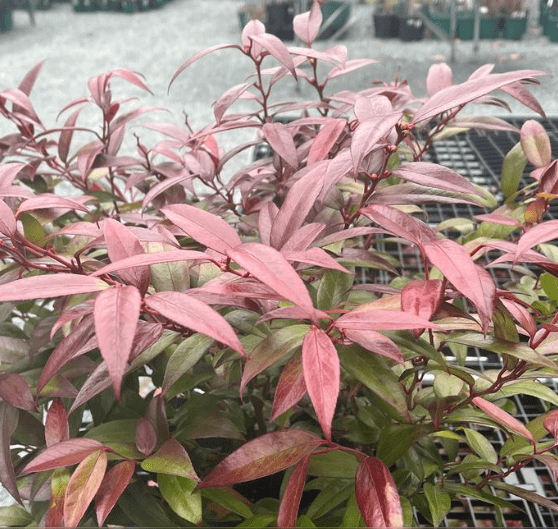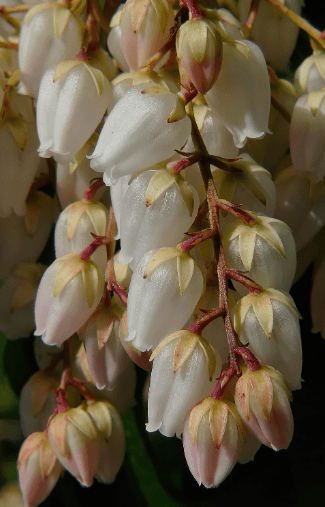
Have you ever admired a bush with bright red leaves and shiny dark green ones while walking in a garden? You may have been looking at Leucothoe compacta.
What Is Leucothoe Compacta?
Leucothoe compacta, also known as Leucothoe fontanesiana ‘Compacta,’ is a lush plant. People admire it for its hanging shape and vivid colors. Now, what is it about this shrub that stands out?
Native Habitat and Ecological Significance
Origin and Natural Setting
Leucothoe compacta does not come from New England. It originated in the Appalachian regions of the United States. This plant thrives in moist, acidic soil. It also plays a vital role in local plant communities.
- A Southern Appalachian Native: Leucothoe compacta only grows in the Southern Appalachian Mountains. It thrives in wet, acidic woodlands. Its healthy growth indicates that the ecosystem is in good shape and not damaged.
- Cultural Importance: Local tribes may have used Leucothoe compacta for healing or for its fibers. Different tribes might use it in various ways, but the plant is important in their traditional practices.
Ecotypic Characteristics
This shrub comes in different kinds based on where it grows. It can thrive in shady areas with some light and in moist, acidic soil. This makes it a good choice for many types of gardens.
Physical Appearance
Glossy Evergreen Leaves
One of the best things about it is its shiny green leaves. These leaves remain dark green throughout the year. They bring lasting beauty to the garden.
Striking Red Leaves and Burgundy Color
As autumn arrives, the leaves turn a deep red color. This bright red gives a unique touch as many other plants start to slow down for the season.
Growth Habits
Cascading Habit
Leucothoe compacta has a nice, soft shape. This makes it good for hills or as a cover on the soil. Its bending branches make it look gentle and pleasing to see.
Densely-Growing Cultivar
Being a plant that grows together tightly, it offers good coverage and can fill gaps nicely. This makes it a good choice for adding privacy or hiding unattractive areas in the garden.
Flowers and Fragrance
Urn-Shaped Flowers

In spring, the bush puts out clusters of flowers that hang down like urns. These bell-shaped flowers are soft and make the plant look even more beautiful.
Attracting Wildlife
The flowers look good. Additionally, they draw pollinators like butterflies and bees.. This helps to increase the variety of life in your garden.
Growing Conditions
Preferred USDA Zones
According to the USDA, Leucothoe compacta grows well in zones 5 to 8. This means it can thrive in many types of climates around the country.
Soil Requirements
It likes wet soil that is a little acidic and rich in organic matter. Good drainage helps prevent root rot, so make sure the spot you plant in doesn’t hold water.
Light Requirements
Filtered shade is the best. It can take some sun, but too much direct light can hurt the leaves. This is especially true in warmer places.
Planting Tips
Choosing the Right Location
Select a safe location to protect the shrub from severe winds. These winds can harm its delicate foliage. A good site is under the canopy of higher trees.
Companion Planting
Think about mixing it with other plants that enjoy shade, such as ferns or hostas. This combination can create a rich, forest garden feel.
Care and Maintenance
Watering Needs
Keep the soil wet, especially when it is dry. Do not let the soil get too soggy. This can cause problems for the roots.
Pruning Guidelines
After the plant blooms, trim it to keep its shape. This allows it to grow thicker. Remove dead or sick branches quickly to keep the plant healthy.
- Timing: Cut Leucothoe compacta right after it flowers. This will help maintain its shape and make it grow thicker. Do not trim it in late fall or winter. This can damage new growth with harsh weather.
- Techniques: To cut off branches that are congested, dead, or broken, use pruning shears that are clean and sharp. To manage the plant’s size or shape, you can also softly trim it.
- Goals: Pruning revitalizes aged plants, encourages new growth, and improves the plant’s appearance.
Common Problems and Solutions
Pests and Diseases
It is mostly free from pests. However, be careful of problems like leaf spot or root rot. Good spacing and proper airflow can help prevent these issues.
- Common Pests: Leucothoe compacta usually does not have pests. However, watch for aphids, scale insects, and spider mites. If you see them, remove them with insecticidal soap or Neem oil.
- Diseases: Root rot can happen if the plant gets too much water or is in soil that doesn’t drain well. Do not overwater, and make sure the area has good drainage. Leaf spots can also affect the plant, especially in humid weather. Remove the affected leaves, and do not water from above.
Dealing with Dry, Shady Spots
Remember to water them often if you plant them in dry and shady spots. Using mulch can help keep the soil moist.
Benefits of Growing Leucothoe Compacta
Year-Round Interest
This shrub has green leaves that stay all year. It changes colors with the seasons. It looks nice all the time. It is an excellent way to keep your garden lively, even in winter.
Wildlife Attraction
The flowers and berries can draw in birds and valuable insects. This helps to build a substantial garden.
Uses in Landscaping
Ground Cover
Its small, hanging style makes it a good cover for shaded areas. Grass can struggle to grow in these spots.
Erosion Control
The large root system holds the soil on slopes. This reduces erosion and helps fix trouble spots naturally.
Propagation Methods
Using Cuttings
The best way to spread Leucothoe compacta is by using semi-hardwood cuttings. Take the cuttings in late summer. Please place them in a moist, acidic mix for good results.
Seed Propagation
While growing from seed can be done, it takes a long time and often does not work well. Most home gardeners like to use cuttings.
Seasonal Care
Winter Protection
Spread mulch around the base in cooler climates. This protects the roots from freezing temperatures. It also helps to keep the soil moist.
Spring Revival
Apply a balanced fertilizer made for plants that enjoy a lower pH in early spring. This will help them grow new leaves and look healthy.
Design Ideas
Incorporating into Shade Gardens
Leucothoe compacta is a great choice for shady gardens. Its shiny leaves look good next to the rough leaves of ferns and the large leaves of hostas.
Container Gardening
If you don’t have much space, consider using a large container for your plants. This lets you move it around to find the best light.
Historical and Cultural Significance
Traditional Uses
Leucothoe plants are mostly used for decoration today. However, people from various cultures have appreciated their beauty for a long time. Be cautious, as some parts of the plant can be dangerous if consumed.
Environmental Impact
Supporting Local Ecosystems
Planting local plants helps local animals. It also improves the variety of life in your garden.
Erosion Control on Slopes
Planting on slopes looks nice. It also helps prevent soil from washing away. The roots of the shrubs hold the soil together.
Selecting the Right Variety
Comparing Cultivars
Leucothoe fontanesiana comes in different types. The ‘Compacta’ variety is smaller and grows closely together. This makes it a good option for gardens that don’t have much space.
Warnings and Precautions
Toxicity to Pets
Be careful if you have pets. Some parts of the plant can hurt them if they eat it. Always keep an eye on your animals near plants they don’t recognize.
Allergy Considerations
People who react to plants should be cautious. This is important when they trim plants, even though it is not a common allergy.
Additional Care Tips
Fertilizing Needs
These plants require very little nourishment. They can, however, grow more effectively and have richer colors if proper fertilizer is used.
Mulching Benefits
Adding organic mulch helps the soil stay moist. In hotter months, it also helps to keep the roots cool.
Enhancing Foliage Color
Maximizing Autumn Colors
To achieve the best burgundy colors in fall, let the plant have some sun in the morning. Then, provide shade in the afternoon. A little extra sunlight can make the leaves more colorful.
Frequently Asked Questions
- Can Leucothoe Compacta Grow in Full Sun?
It’s best to grow it in filtered shade. Excessive sunlight can stress a plant and burn its leaves.
- Is It Deer Resistant?
While it is not fully deer-proof, deer do not find it as tasty as other bushes. This makes it a better choice in places where deer are common.
- Can I grow Leucothoe compacta in full sun? It can take some morning sun, but it prefers filtered shade. The leaves may suffer from too much direct sunshine.
- What are some good companion plants for Leucothoe compacta? You can plant it with shade-loving plants like ferns, hostas, azaleas, or rhododendrons.
- How can I help my Leucothoe compacta to produce more flowers? Make sure the plant gets enough sunlight and water. Pruning it often can also help it grow more blooms.
Final Thoughts
Leucothoe compacta is not just a pretty plant for your garden. It looks nice, is simple to care for, and serves many purposes. This makes it a good choice for all gardeners. If you need to fill a shady spot, stop soil from moving on a slope, or want plants that look great all year, this shrub can provide help.
Ready to Add Leucothoe Compacta to Your Garden?
Why not put this lovely bush in your garden? Caring for it and choosing the right place will bring you beauty and happiness for many years.
Happy gardening!

























